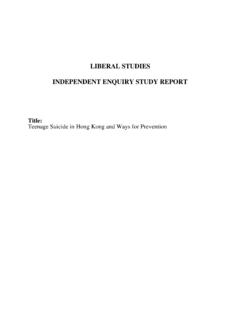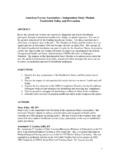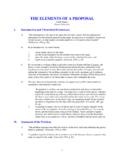Transcription of Introduction to Social Network Methods
1 1 Introduction to Social Network MethodsTable of ContentsThis page is the starting point for an on-line textbook supporting Sociology 157, anundergraduate introductory course on Social Network analysis. Robert A. Hanneman of theDepartment of Sociology teaches the course at the University of California, Riverside. Feel freeto use and reproduce this textbook (with citation). For more information, or to offer comments,you can send me this TextbookThis on-line textbook introduces many of the basics of forma l approaches to the analysis ofsocial networks. It provides very brief overviews of a number of major areas with someexamples. The text relies heavily on the work of Freeman, Borgatti, and Everett (the authors ofthe UCINET software package). The materials here, and their organization, were also verystrongly influenced by the text of Wasserman and Faust, and by a graduate seminar conducted byProfessor Phillip Bonacich at UCLA in 1998.
2 Errors and omissions, of course, are theresponsibility of the of Contents1. Social Network data2. Why formal Methods ?3. Using graphs to represent Social relations4. Using matrices to represent Social relations5. Basic properties of networks and actors6. Centrality and power7. Cliques and sub-groups8. Network positions and Social roles: The analysis of equivalence9. Structural equivalence10. Automorphic equivalence11. Regular equivalenceA bibliography of works about, or examples of, Social Network methods21. Social Network DataIntroduction: What's different about Social Network data?On one hand, there really isn't anything about Social Network data that is all that do use a specialized language for describing the structure and contents of the sets ofobservations that they use. But, Network data can also be described and understood using theideas and concepts of more familiar Methods , like cross-sectional survey the other hand, the data sets that networkers develop usually end up looking quite differentfrom the conventional rectangular data array so familiar to survey researchers and statisticalanalysts.
3 The differences are quite important because they lead us to look at our data in adifferent way -- and even lead us to think differently about how to apply statistics."Conventional" sociological data consists of a rectangular array of measurements. The rows ofthe array are the cases, or subjects, or observations. The columns consist of scores (quantitativeor qualitative) on attributes, or variables, or measures. Each cell of the array then describes thescore of some actor on some attribute. In some cases, there may be a third dimension to thesearrays, representing panels of observations or multiple fundamental data structure is one that leads us to compare how actors are similar ordissimilar to each other across attributes (by comparing rows). Or, perhaps more commonly, weexamine how variables are similar or dissimilar to each other in their distributions across actors(by comparing or correlating columns).
4 " Network " data (in their purest form) consist of a square array of measurements. The rows of thearray are the cases, or subjects, or observations. The columns of the array are -- and note the keydifference from conventional data -- the same set of cases, subjects, or observations. In each cellof the array describes a relationship between the reports liking whom? Choice: Chooser:BobCarolTedAliceBob---011 Carol1---01 Ted01---1 Alice100---We could look at this data structure the same way as with attribute data. By comparing rows ofthe array, we can see which actors are similar to which other actors in whom they choose. Bylooking at the columns, we can see who is similar to whom in terms of being chosen by are useful ways to look at the data, because they help us to see which actors have similarpositions in the Network . This is the first major emphasis of Network analysis: seeing how actorsare located or "embedded" in the overall a Network analyst is also likely to look at the data structure in a second way -- analyst might note that there are about equal numbers of ones and zeros in the matrix.
5 Thissuggests that there is a moderate "density" of liking overall. The analyst might also compare thecells above and below the diagonal to see if there is reciprocity in choices ( Bob chose Ted,did Ted choose Bob?). This is the second major emphasis of Network analysis: seeing how thewhole pattern of individual choices gives rise to more holistic is quite possible to think of the Network data set in the same terms as "conventional data." Onecan think of the rows as simply a listing of cases, and the columns as attributes of each actor ( relations with other actors can be thought of as "attributes" of each actor). Indeed, many ofthe techniques used by Network analysts (like calculating correlations and distances) are appliedexactly the same way to Network data as they would be to conventional it is possible to describe Network data as just a special form of conventional data (and itis), Network analysts look at the data in some rather fundamentally different ways.
6 Rather thanthinking about how an actor's ties with other actors describes the attributes of "ego," networkanalysts instead see a structure of connections, within which the actor is embedded. Actors aredescribed by their relations, not by their attributes. And, the relations themselves are just asfundamental as the actors that they major difference between conventional and Network data is that conventional data focuseson actors and attributes; Network data focus on actors and relations. The difference in emphasis isconsequential for the choices that a researcher must make in deciding on research design, in4conducting sampling, developing measurement, and handling the resulting data. It is not that theresearch tools used by Network analysts are different from those of other Social scientists (theymostly are not). But the special purposes and emphases of Network research do call for somedifferent this chapter, we will take a look at some of the issues that arise in design, sampling, andmeasurement for Social Network analysis.
7 Our discussion will focus on the two parts of networkdata: nodes (or actors) and edges (or relations). We will try to show some of the ways in whichnetwork data are similar to, and different from more familar actor by attribute data. We willintroduce some new terminology that makes it easier to describe the special features of networkdata. Lastly, we will briefly discuss how the differences between Network and actor-attribute dataare consequential for the application of statistical data are defined by actors and by relations (or nodes and ties, etc.). The nodes or actorspart of Network data would seem to be pretty straight-forward. Other empirical approaches in thesocial sciences also think in terms of cases or subjects or sample elements and the like. There isone difference with most Network data, however, that makes a big difference in how such dataare usually collected -- and the kinds of samples and populations that are analysis focuses on the relations among actors, and not individual actors and theirattributes.
8 This means that the actors are usually not sampled independently, as in many otherkinds of studies (most typically, surveys). Suppose we are studying friendship ties, for has been selected to be in our sample. When we ask him, John identifies seven friends. Weneed to track down each of those seven friends and ask them about their friendship ties, as seven friends are in our sample because John is (and vice-versa), so the "sample elements"are no longer "independent."The nodes or actors included in non- Network studies tend to be the result of independentprobability sampling. Network studies are much more likely to include all of the actors whooccur within some (usually naturally occurring) boundary. Often Network studies don't use"samples" at all, at least in the conventional sense. Rather, they tend to include all of the actors insome population or populations.
9 Of course, the populations included in a Network study may be asample of some larger set of populations. For example, when we study patterns of interactionamong students in classrooms, we include all of the children in a classroom (that is, we study thewhole population of the classroom). The classroom itself, though, might have been selected byprobability Methods from a population of classrooms (say all of those in a school).The use of whole populations as a way of selecting observations in (many) Network studiesmakes it important for the analyst to be clear about the boundaries of each population to bestudied, and how individual units of observation are to be selected within that data sets also frequently involve several levels of analysis, with actors embedded at thelowest level ( Network designs can be described using the language of "nested" designs).
10 5 Populations, samples, and boundariesSocial Network analysts rarely draw samples in their work. Most commonly, Network analystswill identify some population and conduct a census ( include all elements of the population asunits of observation). A Network analyst might examine all of the nouns and objects occurring ina text, all of the persons at a birthday party, all members of a kinship group, of an organization,neighborhood, or Social class ( landowners in a region, or royalty).Survey research Methods usually use a quite different approach to deciding which nodes tostudy. A list is made of all nodes (sometimes stratified or clustered), and individual elements areselected by probability Methods . The logic of the method treats each individual as a separate"replication" that is, in a sense, interchangeable with any Network Methods focus on relations among actors, actors cannot be sampledindependently to be included as observations.









